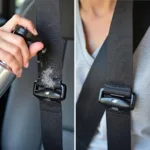Torn leather car seats are a common problem for car owners. They can be caused by a variety of factors, including wear and tear, sun damage, and sharp objects. While it can be frustrating, you don’t necessarily have to replace the entire seat when this happens. There are a number of ways to repair a torn leather car seat, and the best method will depend on the severity of the damage.
Assessing the Damage: How Bad is the Tear?
Before you start any repair, it’s essential to assess the damage to your leather car seat.
- Minor Scratches and Scuffs: These can often be addressed with simple DIY solutions like leather conditioners or repair kits.
- Small Tears and Cuts: These might require patching or the use of leather filler for a more durable fix.
- Large Rips and Extensive Damage: Severe damage often necessitates professional intervention to restore the seat’s structural integrity and appearance.
DIY Repair Options: For the Handy Car Owner
For minor tears and scratches, there are a few DIY repair options that can be effective:
- Leather Repair Kits: These kits typically include a color-matching compound, adhesive, and tools to help you fill and blend the damaged area.
- Liquid Leather: This is a type of filler that can be used to repair small tears and cracks. It dries to a flexible finish that can be color-matched to your car’s interior.
- Leather Patch: For larger tears, you can use a leather patch to cover the damage. This is a more involved repair, but it can be effective if done properly.
Pro Tip from John Miller, Automotive Upholstery Expert: “When using a DIY repair kit, always test the color match on a hidden area of the seat first. This will help you avoid any unpleasant surprises.”
When to Call a Professional: Don’t Let it Get Worse
While DIY solutions can be cost-effective, some situations call for professional help:
- Large Tears or Holes: These often require specialized tools and techniques to ensure a seamless repair that restores the seat’s structural integrity.
- Seam Repairs: Damage to the stitching of your leather seat requires expert intervention to prevent further unraveling and ensure a durable fix.
- Extensive Damage: If the damage to your car seat is widespread or involves underlying components, professional repair is the safest and most effective solution.
Preventing Future Tears: Protecting Your Investment
Once you’ve repaired your leather car seat, you’ll want to take steps to prevent future damage. Here are a few tips:
- Regular Cleaning and Conditioning: Use a leather cleaner and conditioner specifically designed for car interiors. This will help to keep the leather supple and prevent it from drying out and cracking.
- Avoid Sharp Objects: Be careful not to place sharp objects on your car seats. This includes things like keys, pens, and even your phone.
- Use Seat Covers: If you frequently carry passengers or cargo that could potentially damage your seats, consider using seat covers for added protection.
Remember, a torn leather car seat doesn’t have to be a major headache. By understanding your options and taking preventative measures, you can keep your car’s interior looking its best for years to come.
FAQs: Your Questions About Torn Leather Car Seat Repair
Q: How much does it cost to repair a torn leather car seat?
A: The cost can vary significantly based on the severity of the damage and whether you opt for a DIY approach or professional repair. DIY kits can range from $20 to $50, while professional repairs can cost several hundred dollars depending on the complexity.
Q: Can I use superglue to fix a tear in my leather car seat?
A: While tempting, it’s not recommended to use superglue. Superglue dries rigidly and can cause the leather to crack further. Opt for a flexible leather adhesive designed for such repairs.
Q: How long does it take to repair a torn leather car seat?
A: DIY repairs, such as using a repair kit, can take a few hours to a day, depending on drying times. Professional repairs may take a day or two, depending on the complexity and the workload of the shop.
Q: How can I prevent my leather car seats from fading in the sun?
A: Park your car in the shade whenever possible, use a sunshade, and regularly condition your leather seats with a product that offers UV protection.
Q: Can I repair a torn leather car seat myself if I’m not very handy?
A: While minor scratches and scuffs might be manageable with simple DIY solutions, it’s best to consult a professional for anything more severe. Improper repairs can worsen the damage and lead to costlier fixes down the line.
Need help with your car’s audio system in Seattle? Check out our services: car audio repair seattle.



